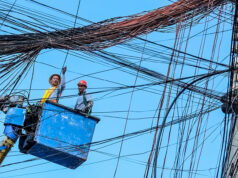BPI income slips in 1st quarter

BANK OF THE Philippine Islands (BPI) saw a decline in its net income in the first three months on the back of higher provisions for loan losses amid the coronavirus disease 2019 (COVID-19) pandemic.
In an online briefing on Thursday, the lender said its net income went down five percent to P6.39 billion in the first quarter from the P6.72 billion booked in the same period in 2019.
The decrease in its profit came on the back of its higher provisions for loan losses worth P4.23 billion during the quarter, surging 135% compared to the P1.80 billion set aside in the same period last year.
“This is in expectation of potential NPLs (nonperforming loans) in the future. This is not something that we see today but with the kind of activity or lack of business activity that we see out there — whether it be corporates or consumers — there is no question that loan losses [will begin] in the future,” BPI President Cezar P. Consing said in the briefing.
Meanwhile, the bank’s revenues jumped by 10.9% to P25.26 billion.
During the period, net interest income went up 13% year on year to P18.14 billion. Net interest margin was at 3.63%, up 24 basis points from the 3.39% seen in January to March 2019 as lower asset yields were offset by lower cost of funds.
The bank’s non-interest income also rose 5.8% to P7.12 billion, supported by higher gains from securities trading.
BPI’s total loans in the first quarter rose 7.3% to P1.45 trillion, with growth seen in areas of microfinance (66.6%), SME (small and medium-sized enterprises) (14.2%), consumer (9.5%), and corporate loan segments (6.7%).
BPI recorded a current account, savings account (CASA) ratio of 73.5%, while its loan-to-deposit ratio was seen at 86.3% during the period.
The bank’s indicative NPL coverage ratio went up to 109.02% in March from the 92.55% seen in the same period a year ago. Its NPL ratio settled at 1.82% at the end of the first quarter.
Operating expenses during the period totaled P12.53 billion, rising by 3.8% compared to the year-ago level. Cost-to-income ratio settled at 49.6%, down from the 53% seen in the comparable 2019 period.
At end-March, BPI’s total assets grew by 5.1% to P2.19 trillion. Total equity was seen at P272.7 billion, with an indicative common equity Tier 1 ratio of 15.19% and a capital adequacy ratio of P16.08%, both beyond the regulatory minimum.
The bank’s return on equity was seen at 9.38%, while return on assets settled at 1.21%.
Maria Theresa Marcial-Javier, chief finance officer at BPI, said the bank is positive they can hold up “reasonably well” in the second quarter despite the current situation and amid an expected economic slowdown.
“We have very good reason to believe that the second quarter earnings will hold up reasonably well even if there is a slowdown in economic activity and loan releases,” Ms. Marcial-Javier said during the briefing.
She said BPI will benefit from declining finance costs on the back of the “strength of their deposit franchise” as well as the “approximately P50 billion” raised through bonds in the first quarter.
During the quarter, BPI raised P15.3 billion in two-year peso bonds and another P33.9 billion via a 1.5-year bonds.
Shares in the Ayala-led lender closed unchanged at P60 apiece on Thursday. — Luz Wendy T. Noble



